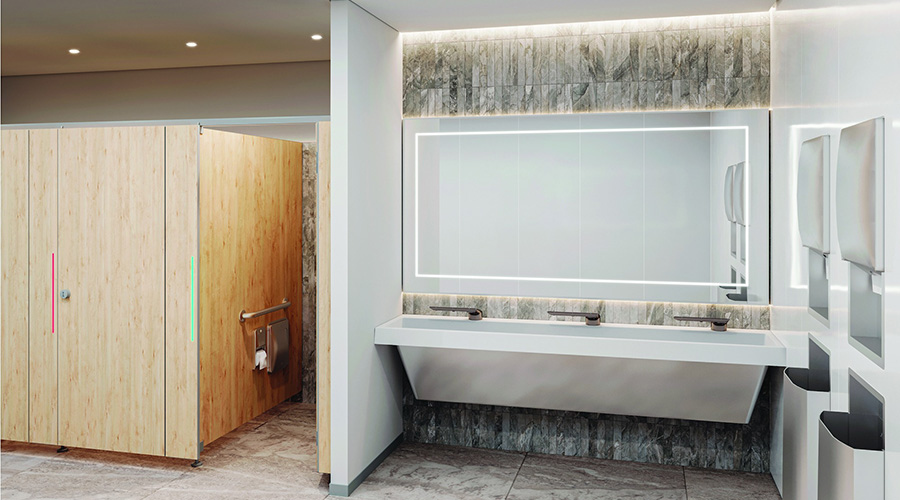Drain Cleaning: Equipment Considerations
A new generation of hand and power tools put more power in the hands of technicians seeking to keep facilities flowing
When decisions on specifying drain- cleaning equipment arise, managers have a range of options from which to choose. From drum machines and water jetters to hand tools and sectional machines, manufacturers continue to upgrade existing products and introduce new models.
Among the challenges for managers in such cases is understanding how equipment technology has changed in recent years, what these changes mean for front-line technicians, and how to select the most appropriate equipment for the task at hand.
Tool Options
A growing array of hand tools and drain- cleaning machines are available to handle even the toughest jobs. Among the most common hand tools are:
• grappler hooks for retrieving hard objects
• flat sewer tape for clearing drains
• hand spinners with a cable magazine and crank for easier trap cleaning
• toilet augers for clearing stoppages in traps. Manufacturers also continue to upgrade their power-tool offerings.
Equipment options in this category include:
• light-duty corded and cordless electric sink machines for clearing traps in sinks, tubs and urinals
• drum machines for use in drain lines up to 6 feet
• sectional machines for longer lines that allow technicians to add sections of cable as it is fed through the machine
• water jetters for no-chemical cleaning of soft sediment and root blockages.
Most of these tools are available in gas, electric and battery-powered versions to offer managers even more options.
Among the additional improvements to drain-cleaning equipment are these:
• High-tensile wire cables in improved packaging that eliminates banding problems and facilitates loading into the cleaning machine. Cable loaders can load cable from the box to the reel on the machine, or on a separate reel off the machine for a preloaded spare.
• Improved locking bits simplify installation of fittings on cables using a variable-speed electric drill or screwdriver. Connecting fittings is much faster using this method, since pliers or wrenches are not needed.
• Manufacturers offer loading ramps that are designed to take the heavy lifting out of moving machines onto and off of truck beds.
• Reel shields protect against open-reel splatter and are designed to reduce job-site cleanup. Also, stands let workers convert portable units for use on floors and countertops.
• More fittings and blades are available to meet specific blockage needs.
• Improved pipe-inspection systems are designed to help workers diagnose a problem. They are comprised of three elements: a control module that can include a VCR or DVD recorder; a push rod up to 300 feet long in 100-foot sections for inserting the head into the line; and a closed-circuit TV camera head. Self-leveling heads fit up to 12-inch lines. Flip-top covers protect the control modules.
Besides new technology, managers also have additional chemical considerations. For example, technicians can use bacterial drain-line cleaners on a scheduled basis as part of the preventive maintenance program. In lines that contain soap, grease and food residue, these chemicals reduce build-up and prevent blockages from forming.
Also, technicians can apply several different rust inhibitors to equipment between uses as a way to prevent oxidation and retain flexibility.
Matching Needs to Options
Hand tools generally are designed for lighter-duty applications. For example, technicians can use grappler hooks fitted with gripping fingers to retrieve objects in traps as far as 6 feet into the drain line.
Flat sewer tapes have a handle and spear point on one end and a roller ball on the other for easier travel around curves and pipe bends. Snakes and toilet augers are tailored to negotiate sharp bends when removing obstructions in toilet traps. Newer models have improved sheathing over the cable to prevent damage to porcelain.
By comparison, power-tool applications are designed for situations that involve heavier buildup, longer drain lines and larger pipe diameters. Typical examples are:
• Powered sink machines with a 1/8 horsepower (hp) motor can be used in small lines up to 21/2 inches, have automatic forward and reverse feeds to eliminate cable kinking, and cable drums that contain cable and prevent splashing. They can operate from countertops or on the floor.
• Drum machines with cables that are 5/8-inch and up to 100 feet long feature torque limiters to prevent sticking in blockages or cable crimps in lines up to 6 inches.
• Sectional machines handle very large jobs with 1/6 hp electric to 6 hp gas motors in up to 10-inch piping. They offer forward speeds up to 500 rpm and reverse speeds up to 250 rpm, along with up to 300 feet of cable, coupled and fed through the machine in sections as each cable length is fed into the pipe.
• Typical water jetters use pressures up to 300 psi, a pulsating action, and flows of up to 4 gpm. They use no chemicals to clear blockages caused by soap, sediment, and grease, and they can restore full capacity in up to 8-inch lines. Several nozzle designs are available, including a root-cutting option.
• Utility pump are designed for trash and sewage handlers. With designs up to 51/2 hp, 250 gpm, and a 3-inch discharge line, these pumps handle up to 5/8-inch solids without blockage.
Equipment Complements
To complement the equipment arsenal, maintenance managers can specify a number of preventive measures that technicians can carry out to address small drain problems before they become larger.
Some facilities, such as restaurants, hotels, and grocery stores, have problems with backups caused by carbohydrate buildup in the lines due to large volumes of soft drinks and other sugary substances. To keep lines at full capacity rather than dealing with backups, workers can pump environmentally safe sugar-residue digestants into the lines through a timed flow meter.
Another preventive measure is to install an add-on T-trap between the sink trap and drain. This enables workers to stop items such as jewelry before they get too far into the line to retrieve. Workers then can remove articles more easily from the trap strainer by opening one convenient cap, rather than disassembling the entire line to address the problem.
Finally, managers should make sure technicians maintain equipment properly, checking units periodically for rusty, dirty, or kinked cable, build-up in drums, dull cutter blades, missing fittings, corroded switch contacts, and discharged cordless batteries. These wear-and-tear problems can slow down the job when speed counts.
Related Topics:











